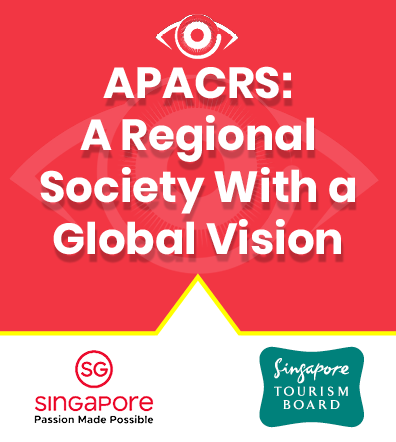Eyeworld Weekly Update |
Volume 20, Number 9 |
27 February 2015 |
- Health Canada gives nod to Xen Gel stent
- NICE approves 2 retina drugs
- Wisdom teeth stem cells may become corneal cells
- Space travel may contribute to astronauts' vision problems
Health Canada gives nod to Xen Gel stent
Health Canada has granted a Class 3 medical device license for the XEN Gel Stent, to reduce intraocular pressure (IOP) in patients with primary open angle glaucoma where previous medical treatments have failed, developer AqueSys (Aliso Viejo, Calif.) said in a news release.
The XEN Gel Stent is "the first glaucoma device to achieve similar IOP reduction as traditional sub-conjunctival trabeculectomy and tube shunt procedures through a minimally invasive technique with less associated surgical and postoperative risk," the release said.NICE approves 2 retina drugs
In a preliminary guidance, the National Institute for Health and Care Excellence (NICE) approved Eylea (aflibercept, Regeneron Pharmaceuticals, Tarrytown, N.Y.) to treat the majority of diabetic macular edema (DME) patients after the European marketer, Bayer, agreed to a patient access scheme to reduce the financial burden on the government healthcare system, but gave a thumbs-down to the drug for individuals with earlier stages of the disease. In December, Germany's cost-effectiveness gatekeeper, the German Institute for Quality and Efficiency in Health Care, said Eylea does not perform any better than Lucentis as a treatment for DME and that it could not assess the drug as a treatment for age-related macular degeneration because Bayer did not provide enough relevant data.
NICE has also recommended Ozurdex (dexamethasone, Allergan, Irvine, Calif.) for the treatment of DME. The draft guidance recommends dexamethasone as a treatment option in patients only where the implant is to be used in an eye with an intraocular (pseudophakic) lens, and their DME does not respond to non-corticosteroid treatment or such treatment is unsuitable for them.Wisdom teeth stem cells may become corneal cells
Stem cells from the dental pulp of wisdom teeth can be coaxed to turn into cells of the eye's cornea and could one day be used to repair corneal scarring due to infection or injury, according to researchers at the University of Pittsburgh School of Medicine. These cells also could become a new source of corneal transplant tissue made from the patient's own cells, the university said in a news release.
Fatima Syed-Picard, PhD, and colleagues showed that stem cells of the dental pulp, obtained from routine human third molar extractions at the university's dental school, could be turned into corneal stromal cells (keratocytes). The researchers then injected the engineered keratocytes into the corneas of healthy mice, where they integrated without signs of rejection. They also used the cells to develop constructs of corneal stroma akin to natural tissue.Space travel may contribute to astronauts' vision problems
An international partnership between Florida State University (FSU) and a team from the Russian Academy of Sciences has found that space travel may severely impair the body's ability to regulate blood rushing to the brain, which could contribute to the temporary or permanent vision problems experienced by astronauts, the university said in a press release. FSU added NASA has become interested in the topic after noting transient vision changes after astronauts returned from short-term flights, but that astronauts return with much more substantial issues after longer flights.
After sending mice into space for 30 days on a Russian satellite, the researchers realized that "When spaceflight alters the function of arteries that precisely regulate blood flow to the brain, it could severely affect many things, including vision," the university said. The two groups are planning on sending another group of mice to the International Space Station for observation in May.RESEARCH BRIEFS
- Significant intraoperative complications likely to affect refractive outcomes and patient satisfaction were low overall in both femtosecond laser-assisted cataract surgery (FLACS) and standard phaco, according to R.G. Abell and colleagues. They conducted a prospective, consecutive comparative cohort case series on 1,852 eyes that underwent FLACS and 2,228 eyes that underwent standard phaco at a single center. Anterior capsule tears occurred in 1.84% of eyes in the FLACS group and 0.22% of eyes in the standard phaco group (P<.0001). Anterior capsulotomy tags occurred in 1.62% of the FLACS eyes. There was no significant difference in posterior capsule tears between the 2 groups (0.43% versus 0.18%). The incidence of significant intraoperative corneal haze and miosis was higher and the effective phacoemulsification time significantly lower in the FLACS group (P<.001). The study is published in the Journal of Cataract & Refractive Surgery.
- Amniotic membrane transplantation in trabeculectomy seems to be a safe and useful procedure for improving the surgical outcome and maintaining low postoperative intraocular pressure (IOP) in patients with a high risk of surgical failure, according to V. Sarnicola and colleagues. The retrospective analysis included 19 eyes from 18 patients with one or more failed trabeculectomies. Trabeculectomy, with amniotic membrane positioned as a "graft" under the scleral flap, was performed. Follow-up was 24 months. The median preoperative pressure was 29 mm Hg, with an average of 2.8 glaucoma medications (range, 1 to 4). At 6 months postoperatively the median IOP was 18 mm Hg with no further significant increases recorded, settling at 19 mm Hg at the end of the 24-month follow-up. Success was achieved in all 19 cases (100%), and only one patient (5%) required postoperative anti-glaucoma therapy to reach the target pressure. At 24 months after surgery, 18 of 19 (95%) amniotic membrane filtering blebs were functioning well without anti-glaucoma therapy. No patients had severe intraoperative or postoperative complications. The study is published in the Journal of Glaucoma.
- Donor tissue with diabetes mellitus (especially with longer disease duration) and hyperlipidemia/obesity were associated with higher failure rates in Descemet's membrane endothelial keratoplasty (DMEK) preparation, and these results may provide useful initial guidelines and benchmark values for eye banks seeking to establish and maintain DMEK programs, according to L.M. Vianna and colleagues. The cross-sectional study included all 563 corneal tissues processed by technicians at Lions VisionGift (Portland, Ore.) for DMEK between October 2011 and May 2014, divided into DMEK preparation failure and DMEK preparation success. The overall tissue preparation failure rate was 5.2%. Univariate analysis showed diabetes mellitus (P=0.000028) and its duration (P=0.023), hypertension (P=0.021), and hyperlipidemia/obesity (P=0.0004) were more common in the failure group. Multivariate analysis showed diabetes mellitus (P=0.0001) and hyperlipidemia/obesity (P=0.0142) were more common in the failure group. Elimination of tissues from donors with both diabetes and hyperlipidemia/obesity reduced the failure rate from 5.2% to 2.2%. The study is published online ahead of print in the American Journal of Ophthalmology.
NEW PRODUCT BRIEFS
- Iridex (Mountain View, Calif.) launched the Cyclo G6 laser platform for the treatment of glaucoma, the company said. The system features a "proprietary MicroPulse tissue-sparing technology and a family of single use probes that connect to an intuitive, user-friendly laser console."
- Rhein Medical (St. Petersburg, Fla.) introduced the Folden Femto Double-Ended Dissector, developed in coordination with David Folden, MD, designed for "smooth opening of all femtosecond laser-created corneal incisions during cataract surgery," the company said. The double-ended instrument measures 0.7 mm at one end, 1.2 mm at the other.
- The European Registry of Quality Outcomes for Cataract and Refractive Surgery, which provides a means to audit surgical results and encourages surgeons to make adjustments to their techniques and improve their outcomes, is now live. Any ESCRS member can access the system free of charge at www.eurequo.org/new/live-system.asp.
 Licensed Publications |
Licensed through ASCRS American Society of Cataract and Refractive Surgery, 4000 Legato Road, Suite 700, Fairfax, VA 22033-4003, USA.
All rights reserved. The ideas and opinions expressed in EyeWorld Asia-Pacific Weekly News do not necessarily reflect those of the ASCRS�ASOA or APACRS. Mention of products or services does not constitute an endorsement by the ASCRS�ASOA or APACRS. Copyright 2008, EyeWorld News Service, a division of ASCRS Media. |



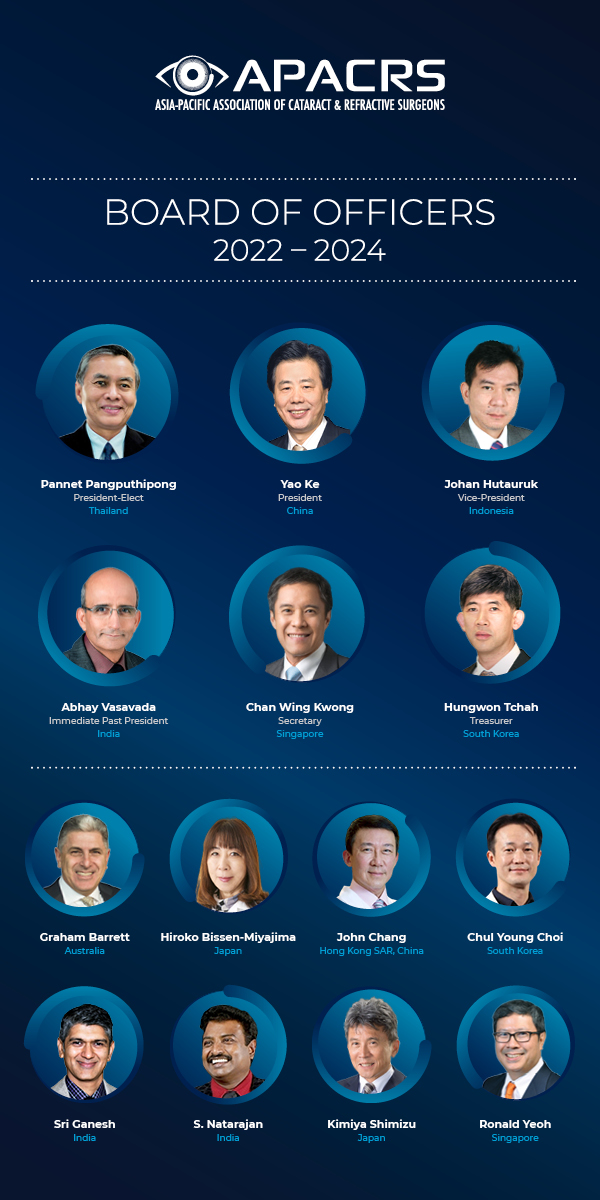
 EyeSustain Update
EyeSustain Update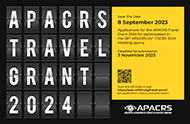 2024 APACRS TRAVEL GRANT
2024 APACRS TRAVEL GRANT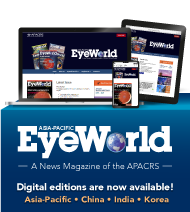 Digital EyeWorld
Digital EyeWorld VOL. 39 (2023), ISSUE 3
VOL. 39 (2023), ISSUE 3  Membership Information
Membership Information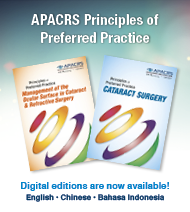 APACRS Principles of Preferred Practice
APACRS Principles of Preferred Practice